|
More opportunities to achieve Peak Performance this January.
|
|
|
|
|
|
Tharp's Thoughts
Inbox Mentoring
|
|
|
|
|
|
|
|
-
Feature: September 19th Update on Cryptoassets, by Van K. Tharp, Ph.D.
-
-
Tips:What’s The Story with Cryptoassets in 2018?, by Van K. Tharp, Ph.D.
-
-
GDPR: Read Our GDPR Statement
|
|
1 of 5 Workshops You Won't Want
to Miss In London This October!
|

|
|
About the Blueprint Workshop
This course is a complete structured program that will launch you to a more advanced skill level in your trading. You’ll learn strategic, focused steps that will serve you throughout your entire trading career.
Overall it’s a course that offers an immense amount of information about what most would consider the unattractive part of trading, yet it is the most critical to successful trading. —Chad Wagner
During these intensive, hands-on three days, you will learn 17 clear and concise tasks to master that will take your trading from ho-hum to visionary. You will leave with a thorough checklist of action steps to guide you to a higher level of performance.
In just three days you’ll see how all of Van Tharp ’s strategic trading concepts fit into one seamless design for more predictable trading results. Your trading will never be the same.
This course illustrates the relationships among the steps so that the process is logical and reasonable. Moreover, Van Tharp will show you how to take each step experientially, so you really get it. Dr. Tharp is an expert in delivering elicitation questions to bring forth each person’s most important issues.
Scroll down to read more about this workshop below.
|
|
|
|
September 19th Update on Cryptoassets
by Van K. Tharp, Ph.D.
|
|
|
|
|
In May 2018 Bloomberg announced that they had formed a cryptocurrency index which is significant for a few reasons. First, Bloomberg only caters to institutional clients so their index is their first step to widespread institutional involvement. Secondly, either in 2018 or early 2019 we will see ETFs for both BTC and ETH. Chances are Bloomberg’s index will form the basis for an cryptoasset index based ETF in the next two years. In that same time period, we are also going to see the SEC end its war with ICOs and end its argument that anyone raising capital with the promise of a profit is selling a security. In addition, the SEC will allow regulated exchanges for cryptoassets to open sometime in the next two years.
After that, institutions will move significant assets into the cryptoasset markets and the eventual market cap will probably be in the neighborhood of 20 trillion dollars.
So let’s take a look at the Bloomberg Index, the Bloomberg Galaxy Crypto Index. The index tracks ten major cryptoassets: Bitcoin (BTC), Bitcoin Cash (BTC), Ethereum (ETH), Ethereum Classic (ETC), Litecoin (LTC), EOS (EOS), Ripple (XRP), and three privacy coins DASH (DASH), Z-Coin (ZEC), and Monero (XRM). They started the index in May at 1000. It reached a high of 1020.73 on May 4th but the index shows a clear downtrend and it’s probably dangerous to invest in the asset class until we at least have two months of stable prices. Here is a graph of the index to date —
|
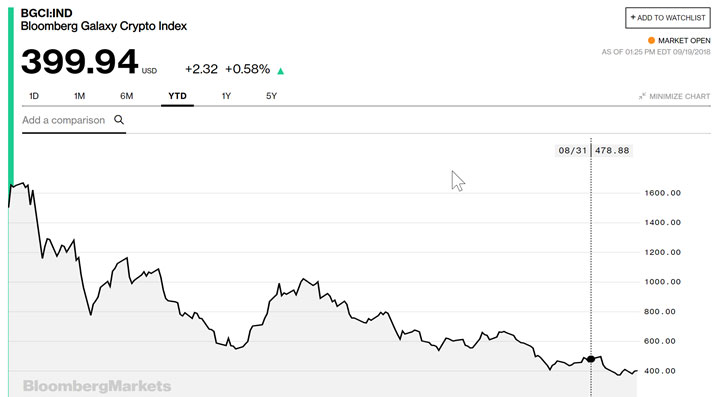
|
|
It’s only a little bit lower than it was last month suggesting perhaps a bottoming (or another dead cat bounce).
Bitwise also has opened a HOLD 10 private index fund that you can actually invest in. The only difference between this index and the Bloomberg Index is that the Bloomberg Index holds Ethereum Classic (ETC) while Hold 10 has Stellar (XLM).
The table below show Bitcoin, a 1st generation crypto asset, plus two second generation crypto assets ETH and NEO, and two third generation crypto assets (Iota and Skycoin). BTC is basically just a ledger whereas Ethereum and Neo both enable smart contract execution based on the ledger. Finally, IOTA and Skycoin are important because they combine smart contracts with huge scalability and zero transaction cost. Just because a crypto is third generation, however, doesn’t mean it will survive and dominate earlier cryptos. I’ve also added the prices for these coins on Jan 15, 2017 to put the current crash into perspective.
|
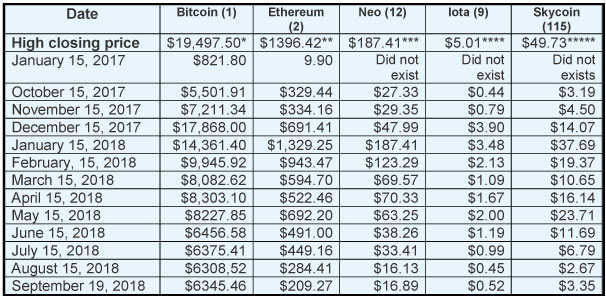
|
|
Date of the All-Time High Closes *Dec 16, 2017 ** Jan 13, 2018 ***Jan 15, 2018 **** Dec 8, 2017 ***** Dec 29, 2017 You will notice that the only coin to go down over the past month is ETH. I have also added a second table which includes the market cap for cryptoassets, the percentage of Bitcoin of the total market cap, the percent of market cap for the top five cryptocurrencies, and the number of cryptocurrencies listed.
|
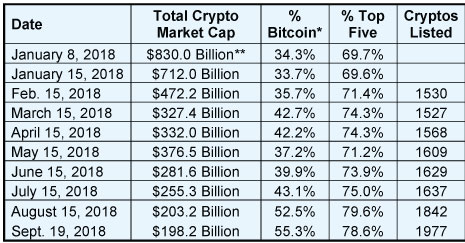
|
|
* Bitcoin was as high as 90% of the market cap of all cryptos at the beginning of 2017 to as low as 32% at the top of the market. Part of the difference is that there are now nearly 2000 cryptocurrencies. SO the number keeps going up even though the market cap goes down.
** This was the peak of the crypto market in terms of market cap. Data via Tama Churchouse, Asia West Investor email on 4/11/18
The data in both of these tables comes from www.coinmarketcap.com.
Notice that the market cap on September 19th has fallen 76.14% since January 8th when we first started doing the crypto monthly update.
Yahoo Finance now lists prices for about 100 cryptocurrencies so I can run some of my normal studies on the data. I’m only looking at those coins for which there is at least 100 days of data – which does not include every crypto in the top 100 list by market cap. However, we have not update the number of cryptos since we started.
|
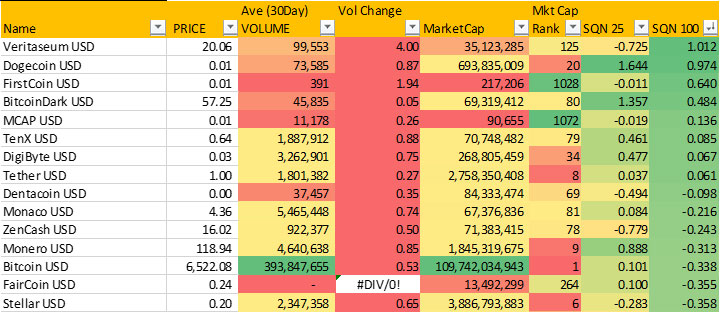
|
|
This month one crypto Veritaseum, has an SQN 100 over 1.0 and we have moved from five positive score to 8 positive scores. That does not, however, signal a change in the market type by any stretch of the imagination. We are in a strong bear market for cryptos.
Cryptos are generally hated and big money is trying to take the market over by scaring people out. Generally, they are doing a good job because this is a very strong bear market. When the institutions believe they have sufficient control and size of the market, they will let the price rise and you can expect to see the first Bitcoin ETF. People will get excited again at that time. See the other article with this month’s update for what is really going on in the crypto universe.
In my crypto market model, I have a different listing for the top 15 and the bottom 15 cryptoassets. The table above uses Yahoo data and the table below uses coinmarketcap.com data. In the next few months, we expect to integrate this information, but for now I’ll just report both sets of data separately. However, it will probably take some time as Coinmarket cap now wants to charge $700 to use their data, so we will switch to another source.
|
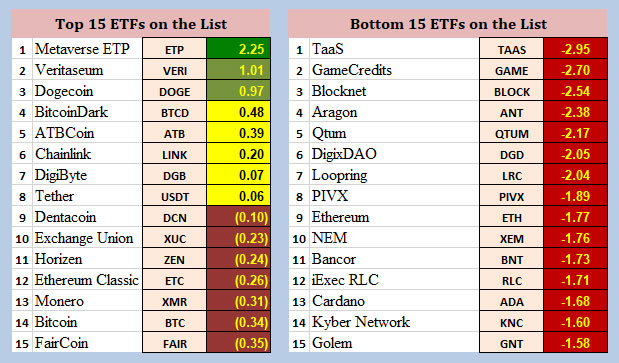
|
|
Notice that in this table we have two cryptos above 1.0 (one above 2.0). And we have still 8 that are positive. We have also classified the coins by type. We expect to improve in time this very preliminary version.
|
|
Last month, there were some green and yellow symbols in these tables – but that turned out to be part of the dead cat bounce. Now, it’s all red and brown. Remember the Bloomberg Index hit an all-time low yesterday on August 15th.
|
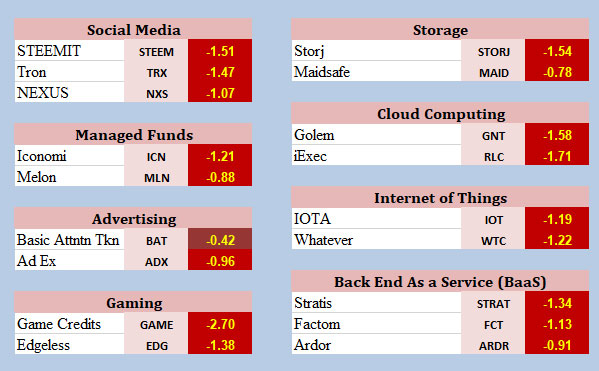
|
|
If I were monitoring the market type, it would definitely be a bear market and I’m sure it would be bear volatile. This market type might continue for a while but the purpose of this report is just to give you a status quo of the cryptoasset markets, not to predict.
As I’ve said before, the blockchain is an institutional revolution, not a technological revolution. Right now institutions determine value and have all the power. Blockchain technology is likely to change all of that by allowing decentralized groups determine value. Institutions (and here I includie big countries), however, will not give up their power easily. Right now, there is a conspiracy going on to keep prices down so that big institutions can accumulate as much as possible while they scare the average guy out of the market.
Bottom Line
- I don’t know what Bitcoin is going to do for the rest of the year. But I would guess the next Bull Market will probably start when ICE comes out with its platform for institutional investors to be able to buy cryptos. That is supposed to happen in about two months.
- I don’t like BTC because it is too slow to send, too expensive to send, and it it’s currently using up $1.5 billion dollars’ worth of our energy to produce. All this for a coin with a market cap right now of $109 billion. However, BTC is planning updates that should change all of that.
- I don’t know if the second and third generation crypto assets (Iota and Sky) will be the primary vehicles of the future. If they survive, I’m sure there will be lots of changes through forks.
- I am convinced that blockchain technology is absolutely here to stay and that the revolution taking place will be the biggest in my lifetime. It will change everything.
- 2018 is currently a difficult year because of lack of clarity around cryptoassets’ status. To some agencies, they are a form of security. To the IRS (and most national taxing authorities), they are property which means a tax event occurs as soon as you sell any. For example, if you use a bitcoin debit card to buy coffee, you have just created a tax event. Cryptoassets need the $600 exclusion rule that applies to FOREX before it can become a major alternative to other currencies.
- In addition, while crypto projects are in their infancy and these small companies have to deal with the SEC, it will be difficult for them to explode into broad adoption. Huge legal issues hamper innovation.
- There will be ETFs for both BTC and ETH at some time in 2019. When that happens, their prices will explode and the crypto market in general will take off big time. Yes, the SEC has turned down numerous requests for an ETF, but it will not turn down the CBOE request that will be coming soon.
- I’ve offered to help my staff create their own crypto portfolio but most are too reluctant to do anything. Only my personal executive assistant and one other staff member have set up one.
- Right now, however, is not the best time to set up a cryptoasset portfolio. Big money hasn’t gotten enough control yet.
- Finally, many of the best traders/investors in the world became that way because of a huge edge and because they were the in the right place at the right time. Cryptoassets offer that kind of edge.
Until the October crypto update, this is Van Tharp. Both RJ and I will be in the UK when the October update is due so it will probably come out towards the end of October.
|
|
|
|
|
|
About the Author: Trading coach, and author, Dr. Van K. Tharp is widely recognized for his best-selling books and his outstanding Peak Performance Home Study program - a highly regarded classic that is suitable for all levels of traders and investors. You can learn more about Van Tharp www.vantharp.com.
|
|
|
|
|
|
|
|
|
What’s The Story with Cryptoassets in 2018?
by Van K. Tharp, Ph.D.
|
|
|
|
|
2017 was a huge bull market in cryptoassets. An investment in early 2017 could easily have gone up 100-fold by the end of the year. 2018, however, has been exactly the opposite. The market cap for cryptoassets as a whole has dropped from $800 billion to just over $200 billion. That means that most of these assets have fallen 70% or more. A 70% fall is more tolerable when it is preceded by gains of 100 times.
As I have said before, cryptoassets and blockchain technology represent an institutional revolution and we haven’t had one of those since the industrial age. Blockchain technology could potentially take over everything and leave huge corporations behind in the dust. But those huge corporations represent the power of today. Power doesn’t give up power easily. Instead, power does its best to absorb and eliminate potential threats. To me, that’s what 2018 has been about for cryptoassets.
First, we had the Securities and Exchange Commission (SEC) say that many new cryptoassets could be securities trying to get around being regulated.
500-1000 new initial coin offerings sprang up in 2017. The SEC publicly stated that many of them were probably securities trying to get around registering with the SEC and complying with US regulation. This means that the people behind about 500 projects risk legal action from the SEC and in many cases dumped their profits to raise funds for legal fees. In fact, in 2018, most of the new crypto projects don’t allow investors from the US because of their fear of the SEC. Elastos, for example, might be one of the better projects out there today but US investors cannot buy it because it is only sold on exchanges that do not allow US investors.
Second, big corporations are saying the BTC and other crypto assets will never amount to anything.
It’s another bubble. It’s all hype. But here actions were quite different from their words.
Here are a few examples.
Jamie Dimon CEO of JP Morgan Chase said, “Bitcoin is a fraud and is a valuation bubble that will burst.” He said that it was only fit for use by drug dealers, murders, and people living in places like North Korea. He said he would fire any employee who speculates in that currency market. Just a few months later, JP Morgan created a new position, dubbed Head of Crypto Assets Strategy. JP Morgan even partnered with ZCash to increase privacy on the blockchain.
Lloyd Blankfein, CEO at Goldman Sachs, said of Bitcoin: “Something that moves 20% {overnight} does not feel like a currency. It is a vehicle to perpetuate fraud. . . Bitcoin is not for me.” He also said, “A lot of things that have not been for me in the past 20 years have worked out, but I am guessing that this will not work out.” Then later we find that Circle, an affiliate of Goldman, had purchased the crypto trading exchange Poloniex. Goldman has also announced its intentions to open Bitcoin derivatives trading and that they will trade in physical Bitcoin, which is strange because all Bitcoin is digital. What they mean is that they’ll be able to deliver actual Bitcoin, instead of a
derivative, which is what is used on the CME.
George Soros called Bitcoin a bubble in January this year. Now his $26 billion fund is now buying it.
Warren Buffett called Bitcoin “rat poison squared.” Buffet’s partner, Charlie Munger. tried to equate trading Bitcoin with the trading of human baby brains — he actually said that. But Buffet and Munger only invest in what they understand and have generally stayed away from anything high tech. Furthermore, they probably feel that their current business is threatened by this new form of technology. They have over $76 billion invested in financial firms which could see their profits centers absolutely gutted by blockchain technology.
All of this amounts to institutional money feeling threatened by cryptoassets / blockchain technology and the only way to deal with such a threat is to take it over and control it. How does big money do that? They are doing their best to drive the price down while they slowly accumulate.
Another issue is that most of the cryptoassets markets are quite unregulated. And that means that they are ripe for manipulation and trading on them is like the Wild West.
In the 1980s the NASDAQ was also such a market. It was frequently called the under-the counter market. The spread (i.e., the difference between the bid and the offer) for such stocks was frequently 50 cents or more. Let’s say a company had such a spread. A firm could buy it on the bid and hold it, Later, they would move up the ask, print the whole order and thus hide a 75 cent spread on say an $7 stock. In addition, they would then charge another 5% commission on top. Their total commission could be as high as 15% and that was legal. However, with increasing regulation and the NASDAQ cleaning up its act, we now can see commissions of 1 cent or even less. Such equity markets have changed dramatically
and that will also happen with cryptoassets. But right now while it’s the Wild West, there is the most opportunity for those who know what they are doing.
Institutional money can buy securities – but they cannot hold them. The U.S. Investment Act of 1940 requires that securities be held by a custodian but there are no such custodians for cryptoassets yet. That’s the reason for at least nine Bitcoin ETF applications have been turned down so far. But this is all about to change.
- Namura Securities, a $100 billion Japanese company, is launching a service to be such a custodian.
- There are rumors that Goldman Sachs might do something similar.
- Northern Trust, which already provides custodial services for most of the major global hedge funds is also rumored to be working on a method to provide custody for cryptoassets.
- State Street, the second largest custodian in the US, is rumored to be looking at becoming a cryptoassets custodian.
- Coinbase, the worlds largest crypto exchange, has acquired a financial firm and will soon be an SEC regulated broker dealer. Suddenly millions of customers are going to be regulated.
- Ledger, which makes the Ledger-Nano Wallet, is also planning on offering a custody solution in late 2018.
- Intercontinental Exchange (ICE) owns the NYSE and 32 other exchanges around the world has partnered with Microsoft, BCG, and Starbucks to create an integrated platform that enables consumers and institutions to buy, sell, store and spend digital assets on a seamless global network. The new company will be called Bakkt.
These new firms and services will allow institutions to enter into the digital marketplace because there will be custodians who will hold and guarantee their assets. Many of these entities have the goal to launch by November 2018. The New York Stock Exchange just announced that they have plans for physical delivery of Bitcoin. So, what that means is that in order for them to physically deliver an actual Bitcoin, not just do a cash-settled transaction like the CME does right now, it means that they must have a solution for custodying or holding the Bitcoin.
And the final piece is that the CBOE has applied for a Bitcoin ETF. The SEC is not going to turn down the CBOE application for an ETF.
TD Ameritrade which has 11 million customers and $1.2 trillion in assets, had filed a patent which can facilitate real time transactions made with digital currencies. The firm is actually going to start teaching their customers about digital currencies.
And there is even more news. The Chinese government has been saying for some time that cryptocurrencies are terrible and that blockchain is evil technology. On the other hand there is a billion dollar blockchain fund launching with Chinese government backing. And a department of the Chinese government has even come out with a list of the top cryptoassets — mostly Chinese based, of course.
India had threatened to totally ban cryptocurrencies but is now saying it might launch its own cryptocurrency.
Finally, by the end of February 2018, over $1 billion had been committed to blockchain ICOs. We are also seeing a lot of legitimate, full-fledged venture capital firms now putting a lot of money into blockchain technology startups.
What does all of this mean?
Three things are about to happen very quickly (by the end of this year I would expect).
First, we will see custodial firms for cryptoassets allowing institutional money to come into the crypto space. Institutional money would love to come into cryptoassets because it’s not correlated with other assets. Just a small investment in cryptos could greatly improve a fund’s performance. Pension funds desperately need this because they cannot perform at the level they need to pay off all of their retirees.
Second, we will see a legitimate Bitcoin ETF - probably the CBOE one. This will probably be followed by an Ethereum ETF and then perhaps one for the Bloomberg Index for Cryptos. When this happens, everyone will be able to easily invest in cryptoassets.
Third, and this might take a little longer, we will see some tax reform on cryptoassets. Right now, you exchange fiat dollars for BTC. Then you use the BTC to buy another cryptoassets. If you have bought and sold Bitcoin already, then you have created a taxable event. This becomes a real pain for anyone who has done a lot of this, however, for any Forex transactions, there is a $600 rule in place. This means that profits on transactions less than $600 are not taxable. I’d hope to see such regulation in the crypto world before the end of 2019.
Any of these three things will take the capitalization of the crypto market to several trillion dollars. This probably means BTC at $50,000 and many of the smaller coins will be up 100 fold. And this is what I’m calling a one in a lifetime investment opportunity.
To help our Super Traders participate in this market, we held a special workshop in June this year and there will be a second one as part of the Super Trader Summit in December.
|
|
|
|
|
|
About the Author: Trading coach, and author, Dr. Van K. Tharp is widely recognized for his best-selling books and his outstanding Peak Performance Home Study program - a highly regarded classic that is suitable for all levels of traders and investors. You can learn more about Van Tharp www.vantharp.com.
|
|
|
|
|
|
|
|
|
Due to Hurricane Florence, the How To Develop Winning Trading Systems workshop has been rescheduled to the dates below.
|
|
|
September 23-25
Sunday-Tuesday
|
|
|
|
|
|
|
The How to Develop Winning Systems Workshop teaches you what you need to know to develop your own system. The material you will learn is not market or time-frame specific. So whether you trade stocks, futures, currencies, gold, etc., or
whether you place 50 trades per day or 50 trades per year, you will learn all of the components that work in any system. With this knowledge you can both modify existing systems to fit you or the market type better, or master your own system development. Two locations to choose from, Cary, NC in September and London, England in October!
|
|
|
|
October 2018 - LONDON, ENGLAND
|
|
|
|
Presented by Van Tharp,
with RJ Hixson
|
|
|
|
October 12-14
Friday-Sunday
|
|
|
|
|
|
|
|
Do any of the following sound like you?
- Are you always looking for a new trading system? Or, are you always trying to improve the one you have?
- Do you find your trade setups never quite fit all of your criteria so you have trouble entering trades?
- Do you get anxious about the market or get anxious about risking your money so that you have trouble pulling the trigger?
- Do you get excited and ignore your rules or do you get distracted and fail to follow your system's rules?
- Does a losing trade take your energy away from the next trade or conversely, does a winning trade make you confident about the next trade?
- Is your trading (or your life?) ruled by fear, anger, greed, or shame?
- Are you constantly losing money?
- Do you lack a strong plan to guide your trading or do you fail to follow the plan you created?
- Do you have a performance ceiling where you fall apart or stop doing well consistently? Does your account reach a certain size and then it plateaus or you start losing money at that point?
If you answered yes to any of these questions, then you are experiencing some form of self-sabotage. But don’t worry, these are some very common patterns for traders and you can overcome them in order to reach your potential. This workshop will help you identify and resolve the underlying conflicts causing these patterns — as well as leave you with the tools to address conflicts that come up in the future for you.
It's been Van Tharp's cornerstone workshop for over three decades. Read more to learn the benefits you will walk away with.
Peak 101 will also be taught in Cary, NC this January. See details under January's workshop schedule.
Peak Performance is also a very important workshop to put on your calendar if you want to qualify for and apply to the Super Trader Program.
|
|
|
|
October 16-18
Tuesday-Thursday
|
|
|
|
|
|
|
The How to Develop Winning Systems Workshop teaches you what you need to know to develop your own system. The material you will learn is not market or time-frame specific. So whether you trade stocks, futures, currencies, gold, etc., or
whether you place 50 trades per day or 50 trades per year, you will learn all of the components that work in any system. With this knowledge you can both modify existing systems to fit you or the market type better, or master your own system development.
|
|
Presented by Gabriel Grammatidis
|
|
|
|
October 20-22
Saturday-Monday
|
|
|
|
|
|
|
|
Presented by Gabriel Grammatidis
|
|
|
|
October 23-24
Tuesday-Wednesday
|
|
|
|
|
|
|
|
The Theory: All You Need to Know About Forex
Gabriel will spend most of the workshop teaching his trend-following systems. The first half day is spent to go over the specifics of trading the Forex market and cover such topics as:
- Why trade Forex?
- What are the advantages and drawbacks of trading Forex versus other instruments?
- What are the main market characteristics, and who are the Forex market participants?
- What methods work best in the Forex market?
- All you need to know about Forex trading sessions and the currency pairs.
- How are Forex chart characteristics different than stocks or futures?
- What do you look for in a Forex broker? What do you avoid?
- Why Forex may actually be the best market for new traders to learn trading.
- What are the trading edges that work in Forex?
- The Method
Gabriel teaches three specific trading systems. All three are trend-based; you can see the price action patterns in the price charts. His systems can be traded in various timeframes and can be traded across a wide range of currency pairs. Attendees of Gabriel’s workshops enjoy swing trading the systems using primarily 5-min ,15-min, 60-min and daily candle charts. The trades tend to evolve over a timeframe of anywhere from several hours to a couple of days (or even weeks, in the case of strong trends).
Two additional days of live forex trading side-by-side with Gabriel is available as well for hands on trading experience.
|
|
|
|
October 26-28
Friday-Sunday
|
|
|
|
|
|
|
|
In this workshop, you begin to build your plan that includes specific, actionable steps you can begin as soon as you get back home. Here are some of the benefits of attending the workshop:
- Assess your beliefs about trading and about yourself so you can leverage your useful beliefs and eliminate the ones that are holding you back.
- Learn how to steer your entire system development process through your objectives.
- Find the key ingredient that most traders and investors are missing in their objectives that will make you thrive financially.
- Create a business plan with 3 trading strategies compatible with the big picture so your trading results are consistently profitable.
- Learn the 8 critical areas of contingency planning that most traders find out about the hard way (i.e., the expensive way). Developing plans for contingencies minimizes the risks to your trading business that could otherwise wipe you out.
- Discover how to leverage the strengths of your personality type and minimize your personal challenges to improve your trading.
- Learn how to cultivate the most important attitude required for successful trading.
|
|
|
|
Presented by Ken Long
Monday includes instruction plus live trades
|
|
|
|
November 10-11-12
Saturday-Monday
Note schedule change.
|
|
|
|
|
|
|
|
|
|
Exciting New Work from Van Tharp
|
|
|
|
November
15-17
Thursday-Saturday
|
|
|
|
|
|
|
|
|
|
Super Trader Summit
For Super Traders Only
|
|
|
|
|
|
|
|
|
|
|
January 2019 - US
This Peak 101 will be presented back-to-back with two other workshops.
Hold on booking travel until we announce those dates.
|
|
|
|
Presented by Van Tharp,
with RJ Hixson
|
|
|
|
January 18-20 (tentative)
Friday-Sunday
|
|
|
|
|
|
|
|
|
|
FREE Book!
We pay for the book, you just pay for shipping.
When you add the free book to an item already being shipped there is generally no extra shipping charge (of course, depending on your location).
Read Van’s Latest Book —
TRADING BEYOND THE MATRIX
The Red Pill for Traders and Investors
Eleven traders tell their stories about transforming
their trading results and lives, in this 400 plus page book.
Below is a brief video on how powerful this book is to traders.
|
|
|
|
GDPR COMPLIANCE:
The European Union General Data Protection Regulation (GDPR) went into effect on May 25, 2018 and is designed to allow individuals to more effectively control their personal data. At The Van Tharp Institute (IITM, INC) , client information is private and confidential; we do not share, trade, or sell to anyone. We never have. You may ask us at any time to unsubscribe. We keep your information safe. If you’d like access to your information just ask. You receive this information from us because you opted into the Van Tharp newsletter either through direct registration or registration through our Tharp Trader Test.
You may opt out below.
102A Commonwealth Court | Cary | NC | 27511
Cary, NC Workshop Information
For a list of nearby hotels for our Cary, North Carolina locations,
click here.
Book your flight arriving to the Raleigh-Durham International Airport (RDU).
When traveling to a three-day course, it's best to arrive the evening before.
To help determine your arrival and departure times, see:
Questions? Click Here to Ask Van...
CONTACT US
This is a supplement to our subscription based newsletter, Tharp's Thoughts.
800-385-4486 * 919-466-0043 * Fax 919-466-0408
|
|
|
|
|